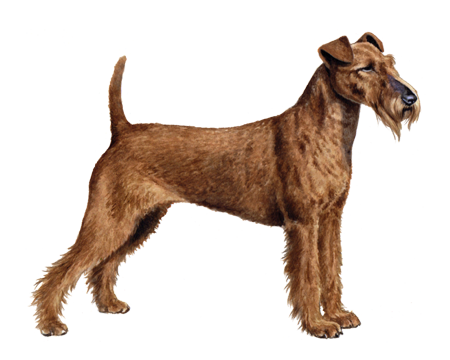
Standard Schnauzer
The Standard Schnauzer is a trustworthy, intelligent, and high-spirited breed. These active, alert dogs require lots of attention and companionship. Schnauzers enjoy participating in family activities and are easy to travel with—making them wonderful pets. They also serve well in police work, herding livestock, therapy, and search and rescue work.
Interested in discovering if your dog is a Standard Schnauzer?
Check out Wisdom Panel's DNA tests.

Standard Schnauzer Traits
General Appearance
Standard Schnauzers are medium-sized, heavy-set dogs that sport a rugged and sturdy build.
Coat and Coloring
The Standard Schnauzer has a wiry outer coat with a close undercoat. The American Kennel Club standard recognizes only two colors: black or salt and pepper. Black and white banded hairs or solid black and white hairs in the topcoat can make up the salt and pepper coat. Some Schnauzers have a fawn undercoat.
Distinctive Physical Traits
Ample facial furnishings trim the face of the Standard Schnauzer. Along with the harsh, wiry coat, a thick mustache, eyebrows, and whiskers are central to the breed's look.
Standard Schnauzer Temperament
The Standard Schnauzer is a highly versatile breed—with a unique personality and distinguished good looks, to boot.
Though they can get bored easily, Standard Schnauzers are quite smart, multi-talented, and trainable. They have also proven themselves to be effective guard dogs, with a deep and robust bark.
Standard Schnauzers are usually protective of children. Sometimes reserved around strangers, they require early socialization to prevent or reduce defensive tendencies.


Standard Schnauzer History
The Standard Schnauzer comes from Germany and the Alpine regions of Switzerland and France. Developed as guard dogs and vermin hunters, Standard Schnauzers often protected coaches and small children.
The oldest of the Schnauzer breeds, the Standard Schnauzer formed the basis for the Miniature Schnauzer and Giant Schnauzer. Experts think the Standard Schnauzer resulted from the cross of a gray Wolfspitz and a black German Poodle.
Initially known as the Wirehaired Pinscher, the modern Standard Schnauzer took shape in 1890. Introduced to the United States in the early 20th century, Schnauzers quickly gained popularity. The breed received American Kennel Club recognition in 1904.
Today, the Miniature and Giant varieties are more popular than the Standard Schnauzer. But dedicated fans of the original breed remain.
Standard Schnauzer Care
Nutrition
Standard Schnauzers need high-quality, age-appropriate dog food. It's important to monitor how much your Standard Schnauzer eats and reduce portions if your pup gains excess weight. Also, remember that giving too many treats can contribute to obesity.
Grooming
Regular grooming will keep your Schnauzer looking their best. Once a week, you should wash their beard and leg furnishings and check in between their footpads for any foreign material. Dental care and nail trims should also be part of your grooming routine.
Exercise
This energetic breed loves to play with its people and other dogs. Schnauzers don't like being left alone, and they may act out in response. These dogs thrive on being a part of every family activity and adventure. Standard Schnauzers also seem to enjoy dog sports—such as agility, tracking, herding, retrieving, rally, and competitive obedience.
Training
Standard Schnauzers tend to be stubborn. But you can overcome this tendency with reward-based training involving small treats and favorite toys.
You should start a firm but gentle training program at an early age, teaching basic commands and manners. Schnauzers dislike the monotony of repetitive training, so aim to keep things fresh. As Standard Schnauzers are a very territorial and dominant breed, be sure to socialize your pup early.

Standard Schnauzer Genetic Health Conditions
-
Chondrodystrophy (CDDY) and Intervertebral Disc Disease (IVDD) Risk
Chondrodystrophy (CDDY) is a skeletal disorder characterized by shortened limbs and abnormal early degeneration of the spinal discs, or intervertebral disc disease (IVDD), which predisposes to disc herniation.
-
Dilated Cardiomyopathy (Discovered in the Schnauzer)
Dilated cardiomyopathy (DCM) is a cardiac disorder causing heart failure.
-
Leukodystrophy (Discovered in the Standard Schnauzer)
Leukodystrophy is a rare inherited disorder affecting the white matter of the brain, causing severe and progressive neurologic signs shortly after birth. The associated genetic variant has been identified in the Standard Schnauzer.
Knowing if your Standard Schnauzer is a carrier or at-risk for these conditions can help you and your veterinarian plan for your pup’s lifelong care. With Wisdom Panel™ Premium, you can get results for over 200 genetic health tests.
Breed Group
Terrier
The Terrier Group ancestors were bred to hunt and kill vermin. They are often characterized as feisty and energetic dogs whose sizes range from fairly small to much larger.
Resources
https://images.akc.org/judges/standard_schnauzer.pdf
https://www.google.com/books/edition/Standard_Schnauzer/a7UJBgAAQBAJ
https://www.akc.org/dog-breeds/standard-schnauzer/
Reviewed July 26, 2020 by Cindy Elston, DVM, MPH
































































